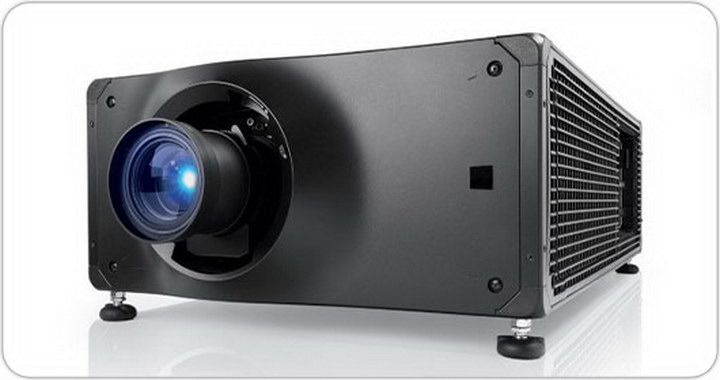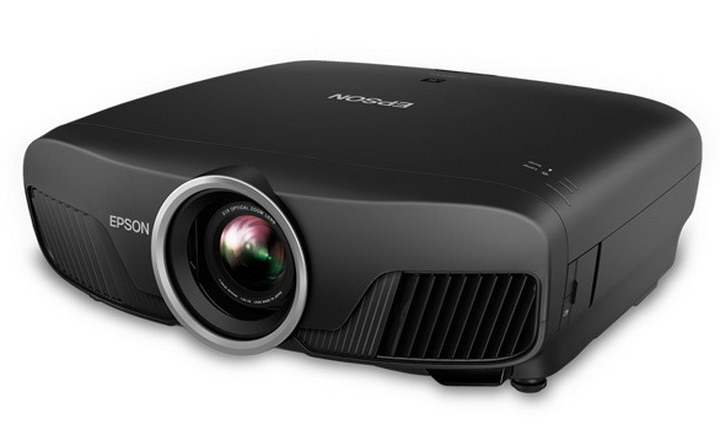Projectors? Are they still around? Does anybody use them any more?

Projection Mapping on the Park MGM Hotel in Las Vegas to introduce Britany Spears upcoming show. (Credit: PaintScaping and Nationwide Video)
The answer is definitely yes, even if projection doesn’t get the news coverage in either the popular or technical literature that it got perhaps 10 years ago. Projection is being squeezed at the small end by LCD and OLED panels of increasing size. At the large size limit, projection is being squeezed by direct-view LED displays. Pete Putman wrote for Display Daily that he can see the end of home theater projectors. Professional projectors are losing market share to direct-view displays. Somebody, however, forgot to tell the projector makers who continue to introduce new projectors. There are applications, such as projection mapping, that simply cannot be done with other display technologies. Other applications, such as digital cinema, can be done by projectors at a small fraction of the cost of alternative technologies such as LED cinema displays.
Four of the 28 Barco UDX 32K projectors used in the Britany Spears projection mapping project. (Credit: PaintScaping and Nationwide Video)
The recent Britany Spears projection mapping project on the Park MGM hotel (formerly the Monte Carlo) in Las Vegas is said by Barco to be “what was probably the largest projection mapping the US has ever seen. The giant announcement was projected from October 18-25 across the façade of the Park MGM, a “canvas” of over 160 meters wide and 26 stories high.” The project used 28 Barco UDX-32K laser-phosphor projector producing a total of almost 900,000 lumens. The projector array was driven by two Disguise D3 4×4 media servers. Four of the projectors were used in portrait orientation, as shown in the image, and the other 24 were used in landscape orientation. You can watch a 3:46 video of the project at the PaintScaping website or on YouTube. The video is hosted by Philippe Bergeron, president and co-founder of PaintScaping, a company that does nothing except projection mapping. It’s worth watching – you not only see the projectors but the results as projected on the Park MGM. A still image just doesn’t do justice to a projection mapping installation.
 Cinema admissions, ticket price and total box office in the US and Canada, 1987 – 2018 (Source: National Association of Theater Owners)
Cinema admissions, ticket price and total box office in the US and Canada, 1987 – 2018 (Source: National Association of Theater Owners)
Another major application of projectors is in the cinema. Admissions to the cinema have been declining in the US & Canada, although revenue has been growing modestly because of increases in ticket prices. In the US & Canada in 2017 there were 43,216 digital cinema screens, according to IHS Markit, and there were an additional 126,059 in the rest of the world for a world-wide total of 169,275. These totals represent about 98% of all cinema screens, with most of the film-only hold-outs in the Asia-Pacific region. Each one of these digital cinema screens, except for the handful that have LED screens, has at least one digital cinema projector and many have two or even more.
 Premium Large Format Screen growth world wide. (Source: IHS Markit via the Motion Picture Association of America)
Premium Large Format Screen growth world wide. (Source: IHS Markit via the Motion Picture Association of America)
Regardless of LED screens from Samsung, Sony and others, LED cinema display walls aren’t going to replace digital cinema projectors any time soon. I couldn’t find data on the total number of LED screens installed world-wide, but it is clear that all of these LED screens qualify as Premium Large Format (PLF) screens. At the end of 2017 (the most recent data available), IHS Markit data showed there were 3162 PLF screens world-wide. This would include not just LED screens but other premium formats such as Dolby Cinema and IMax. Between 2016 and 2017, the number of PLF screens grew 21%. If that growth rate continued into the future, unlikely because of the IHS Markit data shows the ongoing decline of the PLF growth in percentage terms, by 2038 all screens world wide would be PLF. Since LED screens seem to be ideally suited to be PLF screens, this back-of-the-envelope calculation says that in the cinema, all cinema projectors could be replaced by LED screens 20 years from now. Maybe, but don’t count on it. A major barrier to the introduction of LED screens into other portions of the cinema market besides PLF is the cost of these screens compared to the cost of projectors.
 The recently introduced Christie CP2320-RGB and CP2315-RGB projectors (Credit: Christie Digital)
The recently introduced Christie CP2320-RGB and CP2315-RGB projectors (Credit: Christie Digital)
It doesn’t look like the projector manufacturers expect the projector market to disappear any time soon. For example, Christie recently introduced at CineAsia in December (where they were the official projector supplier) two versions of a new, compact digital cinema projector with 2K (2048×1080) resolution and RGB laser illumination. These projectors are the little brothers of the 4K CP4325-RGB. The main difference between the two is the CP2320 has 20,000 lumens while the CP2315 has 13,500 lumens. By comparison, the CP4325-RGB provides 25,000 lumens. Other Christie RGB laser projectors provide higher output but have the lasers external to the projector.
The expected lifetime of all three of these projectors with internal lasers is >30,000 hours to 80% brightness. The CP2320 and CP2315 may be pure-laser projectors do not but still do not have the performance to target PLF applications. Instead they target the many thousands of smaller screens worldwide. Still, they have pretty good performance, better than most people would see in a cinema auditorium today. With a contrast of 3000:1 full on/full off and 1000:1 ANSI, they can’t really properly show HDR content. They are high frame rate (HFR) compatible, with 4K 60fps or 2K 120fps performance out-of-the-box, along with an upgrade path for 4K 120fps capabilities. In addition, their color gamut is said to be 90% of Rec. 2020.
 Sealed, filter-free 3LCD projection engine for the NEC P525 series. (Credit: NEC Display Solutions, Ltd.)
Sealed, filter-free 3LCD projection engine for the NEC P525 series. (Credit: NEC Display Solutions, Ltd.)
NEC hasn’t introduced new cinema projectors recently but they did recently introduce projectors that target the ProAV business markets. On December 20th they announced the mercury lamp-based, 3LCD ME382U / ME342U WUXGA (1,920 × 1,200) projectors that target the lower range of the business market. Incidentally, “lamp” isn’t necessarily a dirty word in the projection business any more. The lamps in these projectors are said to be good for 10,000 hours in normal mode or 15,000 hours in Eco mode. For many business applications with modest usage requirements, the projector will become functionally obsolete without needing a replacement lamp. On December 13th NEC had announced the laser-phosphor 3LCD projectors the P525UL / P525WL. Both of these projectors have 5000 lumen output and the main difference is resolution – one is WUXGA and the other is WXGA (1,280 × 800). These projectors target a higher end of the ProAV/Business market.
 The Sony SRX-R515DS dual projector system has 30,000 lumens output from 6 mercury lamps per projector and can serve screens up to 19.5M wide in 2D or 23M wide in 3D. (Credit: Sony)
The Sony SRX-R515DS dual projector system has 30,000 lumens output from 6 mercury lamps per projector and can serve screens up to 19.5M wide in 2D or 23M wide in 3D. (Credit: Sony)
Sony also has not introduced a new cinema projector lately. Instead, they are selling the benefits of Sony SXRD LCoS cinema projectors to theater owners. The Sony cinema website says “Is your first-generation [Series 1] DLP cinema projector coming to the end of its working life? Are you facing rising maintenance bills? Switch to Sony 4K and benefit from a huge improvement in picture quality plus lower running costs.”
 The Epson Pro Cinema 4050 4K PRO-UHD with HDR projector introduced at CEDIA (Credit: Epson)
The Epson Pro Cinema 4050 4K PRO-UHD with HDR projector introduced at CEDIA (Credit: Epson)
In this DD, so far I have only talked about the four projector manufacturers that serve the cinema market, Barco, Christie, NEC and Sony. There are numerous other projector makers, most notably Epson, the #1 projector manufacturer in the world, that do not serve the cinema market. These companies are all busy introducing new projectors. For example, Epson introduced the Pro Cinema 4050 4K PRO-UHD with HDR projector at CEDIA in September. This 2400 lumen home cinema projector produces 4K (Actually UHD) resolution by pixel shift using FHD (1920 x 1080) LCD panels. It also uses a mercury lamp, with a life of 5000 hours. The projector sells for $2400 MSRP.
There are, in fact, signs of the decline of projection. First, consumer RPTV vanished not recently but years ago, blown away by declining LCD prices and increasing panel sizes. In addition, I used to be a member of the SID PRJ selection sub-committee. This committee selected projection papers for upcoming SID Symposia, before 2017, that is. Unfortunately, industry and academic researchers stopped submitting enough papers on projection so the committee and its members were folded into the DSY (Display Systems) sub-committee. Perhaps that’s where it belongs since large screen projection technology has a lot in common with systems that produce much smaller images like head-up displays (HUDs), near-eye displays (NEDs) and AR and VR head-mounted displays (HMDs), which constitute a major portion of the papers submitted to the SID DSY group. In general, however, SID is not the go-to place for publication of research on large screen displays. In particular, it publishes almost no papers on LED videowalls.
I started in displays in the CRT industry. One popular thing to say (and to believe, if you weren’t in the CRT industry) was that “LCD will replace CRTs within five years.” In fact, it was so popular a thing to say it was said every year for about 20 years. Finally, however, it was true – CRTs have vanished. Will people start saying “LCD and LED displays will be replacing projection within 5 years” for the next 20 years, before it really becomes true? Or will it ever be true? As the Magic 8-Ball would say, “Don’t count on it.” -Matthew Brennesholtz

